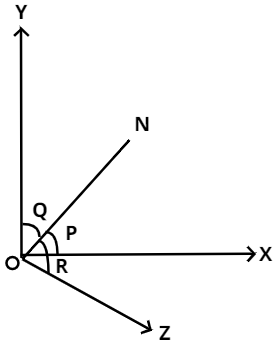
A straight line is equally inclined to all the three axes. Then the angle made by y-axes is
$
{\text{A}}{\text{.}}{\cos ^{ - 1}}\left( {\dfrac{1}{3}} \right) \\
{\text{B}}{\text{.}}{\cos ^{ - 1}}\left( {\dfrac{1}{{\sqrt 3 }}} \right) \\
{\text{C}}{\text{.}}{\cos ^{ - 1}}\left( {\dfrac{2}{{\sqrt 3 }}} \right) \\
{\text{D}}{\text{.}}\dfrac{\pi }{4} \\
$
Answer
220.2k+ views
Hint : Use the concept of direction cosines i.e. make the sum of squares of all the direction cosines as equal to one.

This the diagram of the line equally inclined to all the three axes.
From the Figure we come to know that ON is the line which is equally inclined to all the three axes.
Here we will use the concept of direction cosines $l,m,n$.
From the figure we know
$
l = \cos p{\text{ }}......{\text{(}}i{\text{)}} \\
m = \cos q\,\,\,\,\,\,\,\,\,\,\,\,......(ii) \\
n = \cos r\,\,\,\,\,\,\,\,\,\,\,\,\,......(iii) \\
\\
$
We also know ${l^2} + {m^2} + {n^2} = 1\,\,\,\,\,\,......(iv)$
From the question we come to know $p = q = r = \theta (say)\,\,\,\,\,\,......(v)$
From ${\text{(}}i{\text{),(}}ii{\text{),(}}iii{\text{),(}}iv{\text{)\& (}}v{\text{)}}$We do
${\cos ^2}\theta + {\cos ^2}\theta + {\cos ^2}\theta = 1$
$ \to 3{\cos ^2}\theta = 1$
Therefore,
$\cos \theta = \dfrac{1}{{\sqrt 3 }}$
Then ,
$\theta = {\cos ^{ - 1}}\left( {\dfrac{1}{{\sqrt 3 }}} \right)$
Hence the correct option is B.
Note :- In these types of questions we will always use the concept of cosines . That is the sum of squares of all the direction cosines is one. By using this we can get the answer easily . Drawing figures will make your concept more clear.

This the diagram of the line equally inclined to all the three axes.
From the Figure we come to know that ON is the line which is equally inclined to all the three axes.
Here we will use the concept of direction cosines $l,m,n$.
From the figure we know
$
l = \cos p{\text{ }}......{\text{(}}i{\text{)}} \\
m = \cos q\,\,\,\,\,\,\,\,\,\,\,\,......(ii) \\
n = \cos r\,\,\,\,\,\,\,\,\,\,\,\,\,......(iii) \\
\\
$
We also know ${l^2} + {m^2} + {n^2} = 1\,\,\,\,\,\,......(iv)$
From the question we come to know $p = q = r = \theta (say)\,\,\,\,\,\,......(v)$
From ${\text{(}}i{\text{),(}}ii{\text{),(}}iii{\text{),(}}iv{\text{)\& (}}v{\text{)}}$We do
${\cos ^2}\theta + {\cos ^2}\theta + {\cos ^2}\theta = 1$
$ \to 3{\cos ^2}\theta = 1$
Therefore,
$\cos \theta = \dfrac{1}{{\sqrt 3 }}$
Then ,
$\theta = {\cos ^{ - 1}}\left( {\dfrac{1}{{\sqrt 3 }}} \right)$
Hence the correct option is B.
Note :- In these types of questions we will always use the concept of cosines . That is the sum of squares of all the direction cosines is one. By using this we can get the answer easily . Drawing figures will make your concept more clear.
Recently Updated Pages
Mutually Exclusive vs Independent Events: Key Differences Explained

Area vs Volume: Key Differences Explained for Students

Geometry of Complex Numbers Explained

Electricity and Magnetism Explained: Key Concepts & Applications

JEE Energetics Important Concepts and Tips for Exam Preparation

JEE Isolation, Preparation and Properties of Non-metals Important Concepts and Tips for Exam Preparation

Trending doubts
JEE Main 2026: Application Form Open, Exam Dates, Syllabus, Eligibility & Question Papers

Derivation of Equation of Trajectory Explained for Students

Hybridisation in Chemistry – Concept, Types & Applications

Understanding the Angle of Deviation in a Prism

How to Convert a Galvanometer into an Ammeter or Voltmeter

Understanding Centrifugal Force in Physics

Other Pages
JEE Advanced Marks vs Ranks 2025: Understanding Category-wise Qualifying Marks and Previous Year Cut-offs

JEE Main Marking Scheme 2026- Paper-Wise Marks Distribution and Negative Marking Details

Degree of Dissociation: Meaning, Formula, Calculation & Uses

Ideal and Non-Ideal Solutions Explained for Class 12 Chemistry

Understanding the Electric Field of a Uniformly Charged Ring

Understanding Electromagnetic Waves and Their Importance




